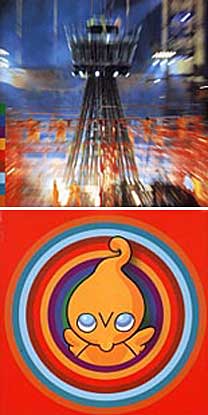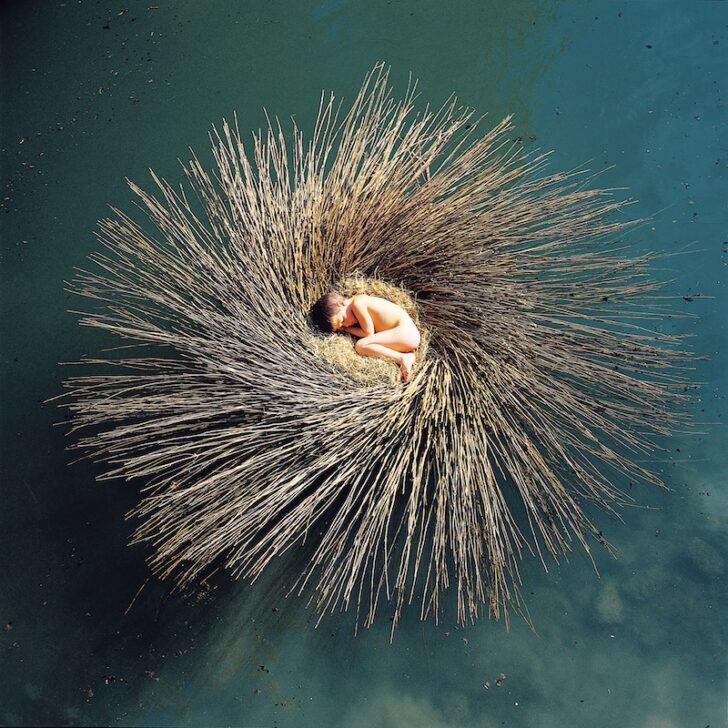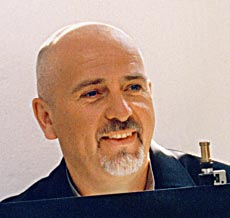- Article
- Read in 10 minutes
Peter Gabriel – OVO: The Millennium Show – review
Before Up came out in 2002, Peter Gabriel got sidetracked by a number of other projects.One of these is the “semi-solo album” Ovo.
Peter Gabriel likes to take his time and get distracted. Us (1992) took two more years than planned, and when Secret World Live was released everybody knew that it would be a while before Gabriel would release new material. So everybody’s ears went up when REM released an album called Up and Peter Gabriel explained that his album will have the same title.
Background
Many people expected the most interesting album of Gabriel’s post-Genesis career to be released quite soon. But Peter Gabriel got distracted and the only thing that did happen was the repeated postponement of the album release. Then, out of the blue, a new Gabriel album was mentioned. But it’s not Up, it’s OVO. He got distracted. When you are an artist and the most versatile person in the Genesis camp you are entitled to be a bit absent-minded. He still managed to get on every fan’s nerves with the continued postponement of the release.

Gabriel once mentioned that he had some 200 songs “in the drawers” – a good reason to get rid of some of them and also provide the music for the central show in London’s commercial failure, the Millennium Dome. But Gabriel were not Gabriel if he did not do far more than sing a bit. He wrote all the music almost all by himself, and he was also involved in the artistic and visual side of the project as well as the development of the story. The cover of the CD reads “Peter Gabriel – OVO”, but this is not So and it is not Us, it is no Peter Gabriel pop album at all.
It still is the direct descendant of Us, Gabriel previous releases which reached us eight years before. So let’s be happy that he finally managed to put out full hour’s worth of musics. In the years before we had to make to with one or two songs a year, which were usually released on costly samplers.
A Musical?
OVO is a kind of musical. No, stop it! OVO is not a musical at all. It is an audivisual show designed to tell a story. The story tells us the conflict of three generations with their different experiences. Basically it’s about the contrast and the union of technology and nature, which works out better musically than one would imagine. More about that in a bit.
OVO has been released in two different versions. First of all there is the Real World version, a sort of double CD with a 40-page booklet that tells the Story of OVO in a comic. The actual music CD lacks the opening song The Story of OVO, but it features a bonus track called The Tree That Went Up. The second CD contains the missing track The Story Of OVO and a Quicktime video accompanied by The Nest That Sailed The Sky. This video is also included in the multimedia portion of the normal version. Both releases differ from each other in their artwork. The official album version has a typical Gabriel cover and many images could already be seen on the Eve CD-ROM.
Two different cover images
The cover image of OVO, for example, is the back cover image of Eve. The Real World Version includes fotos of the Millennium Dome show, some comments by the designers, producers and other involved people, but, in difference to the standard version, no lyrics. Comprehensive details are provided for every song in both versions.
OVO has turned into a playground for Gabriel’s experience in multimedia and multicultural musical influences. OVO is not just music. When you listen to it you can feel that Gabriel tried to channel the variety of the whole world into these 60 brief minutes of music. He knows best that that does not always work out alright, but the album features some of the most remarkable moments in the career of an artist that has not at all been free from highlights.
Musicians & Music
The musicians involved all have made a name of themselves in the business. Genesis fans will notice the name Richie Havens. Havens sang two songs on Steve Hackett’s album Please Don’t Touch in 1977…

The CD begins with something that is absolutely un-Gabrielese – a rap. Along with a couple of other vocalists Neneh Cherry lent her voice for The Story Of OVO. She had worked with Youssou N’Dour before (for Seven Seconds). Gabriel sings (not raps) the chorus himself. The title song sounds outlandish, it is not a typical Gabriel song at all. It is not even typical for the album, but none of the twelve tracks really is. The opener is supposed to tell the listener what OVO is about. In interviews, Gabriel never tried to disguise the fact that he chose a rap to appeal to the younger generation.
The spirit of Mike Oldfield haunts Low Light. Slow piano sounds are added to an ambient beginning, and near the end the enchanting voice of Iarla Lionáird carries off the song. Lionáird is the lead vocalist of Real World’s most successful output to date, the Afro Celt Sound System who recently had a top-40 album and a top-10 single in England. The Real World version of OVO opens with this song – a completely different entry to the album. It is during Low Light that the magic of Gabriel’s music begins to work
Richie Havens sings on The Time Of The Turning, and it slightly resembles Hackett’s How Can I? Havens’ voice is very striking. Peter Gabriel once said it sounded as if “he had lived in it for a long time”. The chorus is sung by Elizabeth Frazer, and this is where we encounter the first problem. The beautiful melody and the excellent arrangement this one of the highlights, but neither booklet reveals who sings next to Richie Havens. According to the voice it must be Elizabeth Frazer who sings again on another track. But the name is not that important.
The Time Of The Turning is world-class, a piece of art in music made by Peter Gabriel. The lyrics and the division of the voices into verse and chorus remind one of Gabriel’s classic Don’t Give Up. It does not become clear who sings the optimistic part and who sings the other half. Both of them seem to cover the whole range. The Time Of The Turning is about starting out into the future and about the courage this step requires.
The next number is an instrumental designed as a kind of Real World Festival. Everybody can participate in the music and lots of Real World musicians do. The Man Who Loved The Earth / The Hand That Sold Shadows sounds like something that grew out of a couple of ideas left over from the Passion album. The drums are the most prominent instrument in this number that consists of two parts, as the title insinuates.
Right after that there is a short reprise of The Time Of The Turning that was joined in a kind of symbiosis with The Weaver’s Reel. The reprise is a little faster and less balanced, The Weaver’s Reelis up-tempo folklore and sounds like something that could be played at merry celebrations in the Far East – or in Ireland. You may dance. Elizabeth Fraser takes care of the vocals.
And here we are now, listening to the first Gabriel “solo track” of the CD. Father, Son is a typical measured Gabriel number along the lines of the 1990 re-recording of Here Comes The Floodor his cover of That’ll Do from the Babe: Pig in the City sound track. Songs like that are just made for Gabriel’s voice. It’s no surprise that he does the vocals himself. Gabriel once explained in an interview that he had planned this song for Up, but that its topic fit the OVO concept very well. It’s about the generation conflict. Gabriel was inspired by his own family, his daughters and his parents.
All this musical harmony is suddenly shattered by an earthquake called The Tower That Ate People. With Peter singing we once more hear the backbone of his recent live tour band (1993/4): David Rhodes, Tony Levin, Manu Katche. The song is violently destructive, it digs up dirty sounds and Gabriel’s voice is terribly distorted during the first half of the song. Today one would call it industrial, or maybe alternative, or gothic. This song shows Peter Gabriel’s class once more. The Tower That Are People is Gabriel’s answer to David Bowie, Depeche Mode and U2, bands that dominated the 90s long after Gabriel began to experiment with jarring and dirty sounds. The way he brings his voice to bear on this sound monster is fascinating. Another highlight of the CD.
Revenge is another drum festival. Brief though it is, it is very effective. As is White Ashes, a collage of wild sounds and weird singing. White Ashes may not be to everyone’s liking. But together with The Tower That Ate People and Revenge it is a fine trilogy representing the world of technology on OVO.
If the previous three numbers left you cold, you’ll be delighted when you reach Downside Up. Elizabeth Frazer opens the song and Paul Buchanan, lead singer with The Blue Nile, adds his own singing in the next verse. Buchanan’s voice closely so resembles Peter Gabriel’s that one wonders why Peter did not sing it himself. Still, it does not harm the song which is still about the conflict between nature and technology. The fears, however, are fading away. The lyrics feature a typical Gabriel-style pun: “all the strangers look like family, all the family look so strange”.
A similar line can be found in I Grieve (City of Angels soundtrack): “Did I dream this belief? Or did I believe this dream?” This may have been another song that originally was planned for Up, but there are not reliable statements about it. Around the middle of the song a big instrumentation comes in and drives the song on. The chants of “OVO, OVO” add another fine dynamic layer before the initial chorus is sung over the new rhythm at the end. Downside Up may be the CD’s highpoint.

The Nest That Sailed The Skyis the only song that does not really lead anywhere. The instrumental may have been planned as a moment to catch your breath, but somehow it does not sit well between Downside Up and the gripping final song Make Tomorrow. The Nest That Sailed The Sky is part of the Millennium Dome Show. That’s why it was included on the CD.
The Real World version of the album continues with a bonus track, The Tree That Went Up. It is another instrumental, but the instruments were chosen and arranged more carefully than for the predecessor. The drums play a leading role before things calm down a bit for the finale, Make Tomorrow.
Make Tomorrow is a beautiful ballad in which nature and technology are reconciled. All vocalists involved in the making of the album, Iarla Lionáird excepted, sing on this song. Richie Havens as well as Gabriel’s part send shivers down your spine. The message is evident from the title. This ten-minute song ends in a richly arranged instrumental part leaving the listener alone with their thoughts.
All in all
What do we take home from this album? The many beautiful voices and melodies? the well-balanced arrangements? The instrumental drum festivals? The question mark at the beginning of The Tower That Ate People? Or the exclamation mark at its end? Perhaps it’s this: On OVO, the artist Peter Gabriel has had the first good romp in a number of years – just like the Passion soundtrack ten years before. He has written a crystal-clear concept album with all the strengths and weaknesses that concept albums already had at the time of The Lamb … Peter Gabriel still paints a different musical image than his pop colleagues do.
And that’s the merit of this album. He has his unique voice stand aside for the benefit of art. OVO is no milestone like Us and So, but it is still miles away from other musical efforts. And let’s not forget that OVO is no real Gabriel album after all. It works surprisingly well for a concept album. Besides, Gabriel had to meet deadlines because even he could not delay the turn of the millennium like he has been delaying Up for a long time.
The critics did not really like the album. Perhaps it was asking to much of critics who usually review mainstream of hard rock music. Peter Gabriel himself sums it up nicely: “I’ve learned to accept that not everybody on this world will love me.”
We could (or should) see this album as an appetizer for his next proper album Up which, as Gabriel insinuated, may be released this year. It is to be hoped that Peter Gabriel will not be offended if we believe that statement only when we find the CD in the shops. Until that happens we will enjoy these fine new songs. And we admire the musical versatility of the former lead vocalist of Genesis.
by Christian Gerhardts, July 2000
translated by Martin Klinkhardt

